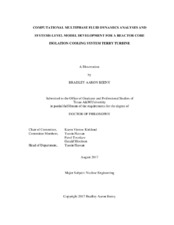| dc.description.abstract | The Reactor Core Isolation Cooling (RCIC) system found in certain boiling water reactor (BWR) power plants is intended to provide make-up coolant to the reactor pressure vessel (RPV) when it is isolated from the power-producing steam turbine and condenser. Since the Fukushima-Daiichi nuclear power plant accident in March of 2011, the RCIC system has drawn special attention from members of the nuclear industry and government regulators for its apparent role in removing residual decay heat at units 2 and 3 for far longer – 70 and 20 hours, respectively - than the 4 to 8 hours typically credited. The RCIC system in units 2 and 3 mitigated severe accident progression under circumstances well outside its own design basis, delaying core damage for a time. These observations suggest the RCIC system is perhaps a more robust and capable safeguard against core damage than previously thought, especially in the context of beyond-design-basis accidents like short-term or long-term station blackout events. As such, the RCIC system merits further study in pursuit of an increased level of understanding. If better analytical methods are developed and applied, the findings may lead to revised severe accident management strategies and more resilient nuclear power plants in the United States and abroad. The goals of this dissertation are essentially to develop, implement, apply, and validate sufficiently detailed mathematical models of the RCIC system that it may be better understood. This analysis occurs at two disparate levels of physical detail: the computational multiphase fluid dynamics (CMFD) level and the systems level.
For CMFD level analyses, a quasi-two-fluid dispersed phase flow model was developed for implementation into STAR-CCM+. Results were validated to the extent possible via experimental benchmarks. Data useful for systems level modeling purposes was obtained from CMFD, including several factors for MELCOR turbine velocity stage and pressure stage modeling. For systems level analyses, RCIC system Terry turbine mathematical models (for the pressure and velocity stages) were developed for implementation into MELCOR as was a new centrifugal pump model (homologous pump model). New systems-level model capabilities were demonstrated with example problems. Some important observations were made regarding RCIC system performance under off-normal conditions, namely that: 1) the RCIC turbine could be capable of operating with a wide-open governor valve without reaching its mechanical over-speed set-point, and 2) the RCIC system could be capable of self-regulating under two-phase flow conditions resulting from a cyclic pattern of reactor pressure vessel re-fill and over-fill. The new MELCOR models developed herein will certainly enable users to investigate RCIC system thermal-hydraulic response in greater detail and with higher fidelity. | en |


